Alice Barber Stephens
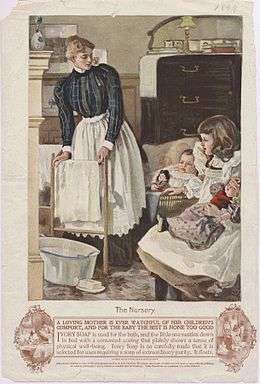
Alice Barber Stephens (July 1, 1858 - July 13, 1932) was an American painter and engraver, best remembered for her illustrations.
Early life and education
She was born on a farm in Salem, New Jersey, and attended local schools. Her Quaker family moved to Philadelphia, Pennsylvania, and at age 15 she became a student at the Philadelphia School of Design for Women (now Moore College of Art). She entered the Pennsylvania Academy of the Fine Arts in 1876, where she studied under Thomas Eakins. She later studied at the Drexel Institute under Howard Pyle, and in Paris at the Académie Julian and the Académie Colarossi. She exhibited at the Paris Salon in 1887.[1]
New Woman
As educational opportunities were made more available in the 19th-century, women artists became part of professional enterprises, including founding their own art associations. Artwork made by women was considered to be inferior, and to help overcome that stereotype women became "increasingly vocal and confident" in promoting women's work, and thus became part of the emerging image of the educated, modern and freer "New Woman".[2] Artists then, "played crucial roles in representing the New Woman, both by drawing images of the icon and exemplyfying this emerging type through their own lives."[3]
Late 19th century
In 1890, she married Charles H. Stephens (1855?-1931), an instructor at PAFA. They had one son, D. Owen Stephens (1894–1937), who also became an artist. The Stephenses had architect Will Price convert a stone barn in the utopian community of Rose Valley, Pennsylvania into "Thunderbird Lodge" (1904), a sprawling house that contained studios for both of them.[4]
In 1890, Stephens won the Mary Smith Prize at the annual Pennsylvania Academy of the Fine Arts exhibition.[5] Her work regularly appeared in magazines such as Scribner's Monthly, Harper's Weekly, and The Ladies Home Journal.[6] She illustrated books by Nathaniel Hawthorne, George Eliot, Henry Wadsworth Longfellow and, notably, the 1903 edition of Louisa May Alcott's Little Women.
With artist and educator Emily Sartain, she was one of the founders of The Plastic Club of Philadelphia (1897), the oldest art club for women in continuous existence.[7] At that time, she taught at the Philadelphia School of Design for Women and worked as an illustrator.[8]
Later life and legacy
Stephens's artistic career spanned 50 years, during which she also lectured, taught, and judged painting and photography. She died at "Thunderbird Lodge" in 1932.
Her papers are in the Archives of American Art at the Smithsonian Institution.
Selected works
- Women's Life Class (circa 1879), Pennsylvania Academy of the Fine Arts, Philadelphia, Pennsylvania.[9]
- Engraving of The Chess Players by Thomas Eakins (circa 1880).
- Engraving of First Lady Lucy Webb Hayes (circa 1880).
- Illustrations for Sarah Orne Jewett's An Every-Day Girl (1890).[10]
- Spring Morning in the Park (circa 1890).[11] Exhibited at the 1893 Chicago World's Columbian Exposition.
- The Germania Orchestra at the Pennsylvania Academy of the Fine Arts (1891), Biggs Museum of American Art, Dover, Delaware.[12]
- Christmas on Fifth Avenue (1896).[13] Currently for sale at Chappell & McCullar Gallery, San Francisco, California.
- The Nursery (1898), Ivory Soap advertisement.
- The Piano Lesson (circa 1900).[14]
Gallery
-
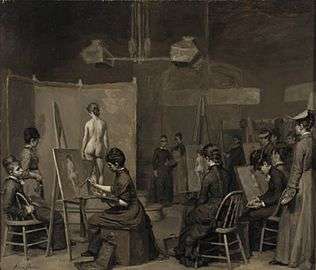
The Women's Life Class Scribner's Monthly (1879)
-
.jpg)
Engraving of The Chess Players by Thomas Eakins (circa 1880).
-
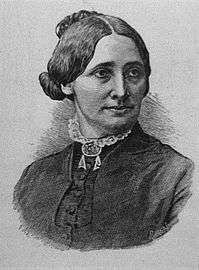
Engraving of First Lady Lucy Webb Hayes (circa 1880).
-
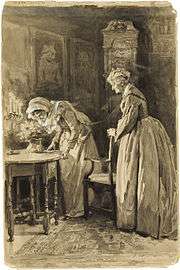
Their Perfume Flooded the House ink on board (1892)
-

The Bear Hunter oil on canvas (1896)
-
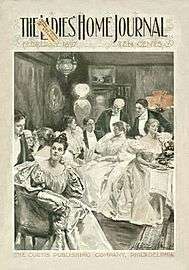
Ladies Homes Journal cover February 1897
-

John Wesley Teaching His Sunday School oil on canvas (1897)
-
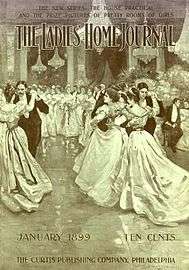
Ladies Home Journal cover January 1899
-

Christmas on Fifth Avenue 1896
Notes
- ↑ Alice Barber Stephens from Schwarz Gallery.
- ↑ Laura R. Prieto. At Home in the Studio: The Professionalization of Women Artists in America. Harvard University Press; 2001. ISBN 978-0-674-00486-3. pp. 145–146.
- ↑ Laura R. Prieto. At Home in the Studio: The Professionalization of Women Artists in America. Harvard University Press; 2001. ISBN 978-0-674-00486-3. p. 160–161.
- ↑ Thunderbird Lodge from Rose Valley Museum & Historical Society.
- ↑ Pennsylvania Academy of the Fine Arts (1914). Catalogue of the Annual Exhibition of Painting and Sculpture. pp. 10–11.
- ↑ January 1899 cover, Ladies Home Journal from American Gallery.
- ↑ Alice Barber Stephens from plasticclub.org
- ↑ Dennis P. Doordan (1995). Design History: An Anthology. MIT Press. p. 86. ISBN 978-0-262-54076-6.
- ↑ Women's Life Class from PAFA.
- ↑ An Every-Day Girl from Coe College.
- ↑ Alice Barber Stephens from U.S. Women Painters.
- ↑ Germania Orchestra at PAFA from Biggs Museum.
- ↑ Christmas on Fifth Avenue from Chappell & McCullar Gallery.
- ↑ The Piano Lesson from American Gallery.
Further reading
- Brown, Ann Barton. Alice Barber Stephens: A Pioneer Woman Illustrator. Brandywine River Museum, 1984.
- Copans, Ruth. "Book illustrated: text, image, and culture, 1770-1930; New Castle, DE; Oak Knoll Press Dream blocks: American women illustrators of the Golden Age, 1890-1920." (2000).
- Goodman, Helen. "Women illustrators of the golden age of American illustration." Woman's Art Journal 8, no. 1 (1987): 13-22.
- Kitch, Carolyn. "The American Woman Series: Gender and Class in The Ladies' Home Journal, 1897." Journalism & Mass Communication Quarterly 75, no. 2 (1998): 243-262.
- Thomson, Ellen Mazur. “Alms for Oblivion: The History of Women in Early American Graphic Design”. Design Issues 10 (2). (1994): 27–48. See p. 32 for Stephens' training in context with other women artists.
External links
| Wikimedia Commons has media related to Alice Barber Stephens. |
- Alice Barber Stephens Papers at the Smithsonian Archives of American Art
- Alice Barber Stephens Collection at The Library of Virginia
- Alice Barber Stephens at the Delaware Art Museum
- Alice Barber Stephens at Rose Valley Museum & Historical Society
- List of 49 works by Alice Barber Stephens at SIRIS (Smithsonian Institution Research Information System) Art Inventories Catalog
- Alice Barber Stephens at AskArt
- Alice Barber Stephens at Artnet
- Online books with Alice Barber Stephens illustrations
- Works by Alice Barber Stephens at Project Gutenberg
- Works by or about Alice Barber Stephens at Internet Archive